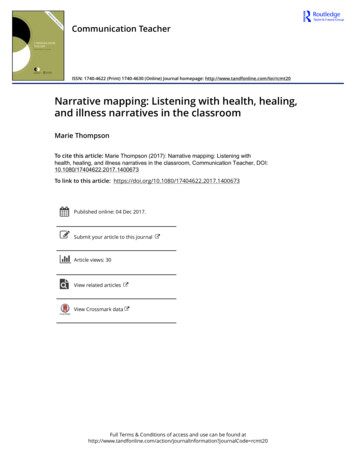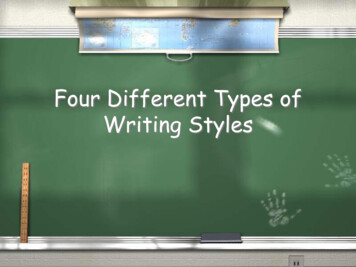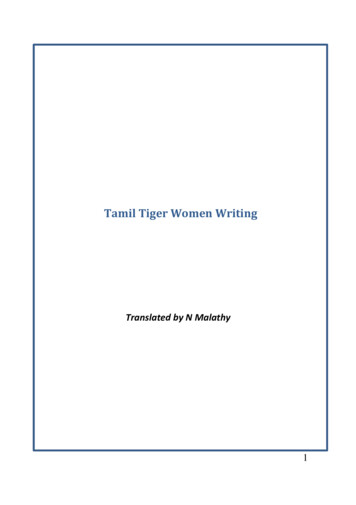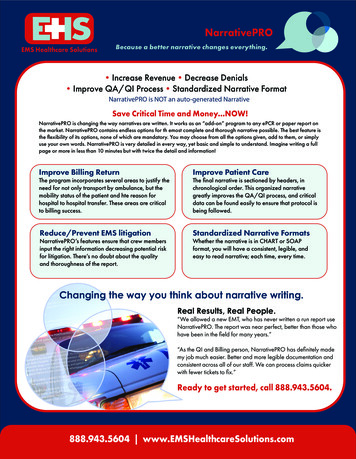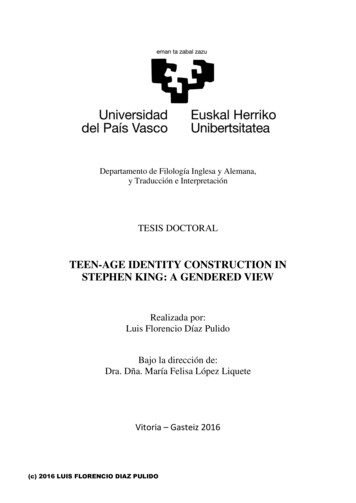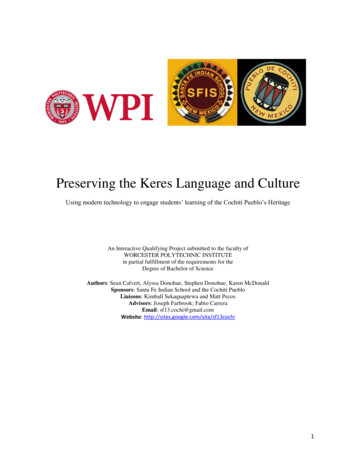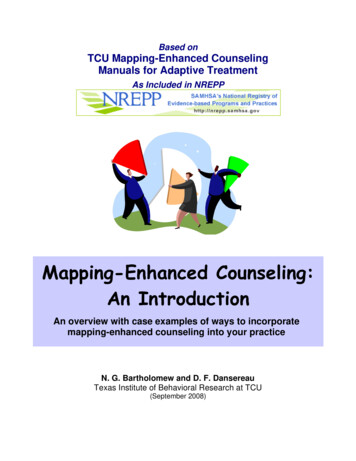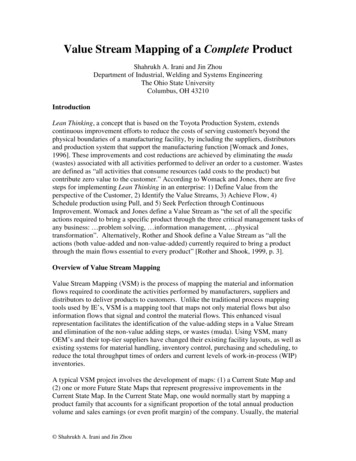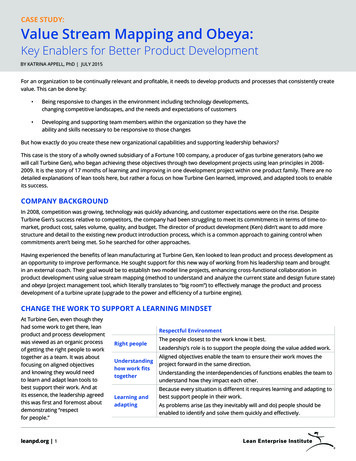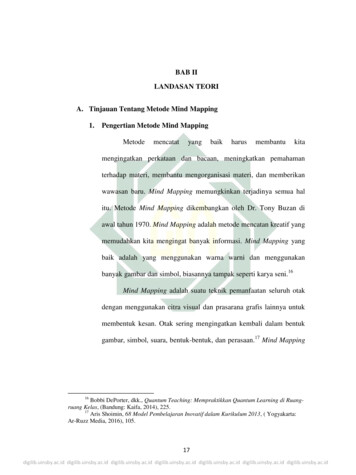
Transcription
1Narrative MappingBy Stephen MamberUCLA Dept. of Film, Television, and Digital MediaThis appeared (in a slightly different version) in:Anna Everett and John Caldwell (eds.), New Media: Theories and Practices ofIntertextuality, Routledge, 2003, pp. 145-158.Illustrations appear at the end.I want to attempt to link up a variety of areas of creative endeavor which I believehave a common goal. As I don't think these strands have yet been pulled together andgiven a name, I want to try to do so here. This is also valuable to do because digitalmedia bring out the possibilities for further work here like never before, especially forsuggesting new interface possibilities.I would call this activity "narrative mapping" and give it a simple and broaddefinition: an attempt to represent visually events which unfold over time. This would bemapping (rather than just presenting a picture), because space, time, and perhaps othercomponents of the events would be accounted for. A visual information space isconstructed that provides a formulation of complex activities.These mappings may be of real or fictional narratives, but my own feeling wouldbe that the latter presents the greatest challenges, because mapping becomes a form ofcritical visualisation. ("Critical Visualisation" might be a useful alternative term to"Narrative Mapping".) Take virtually any great work of literature or film and try to askyourself: what would a mapping of this work look like? While both the fictional and thereal can be mapped, it's useful to distinguish between the two to consider possibledifferences between mapping strategies. Our conclusion may be that the only differenceis of available information (finite in the case of fiction). I am principally arguing that
2fictional mapping is both possible and productive, and extends from real-world mappingpractices.The kinds of activity which can be linked to this enterprise have been showing upin a lot of places. What has been happening (or could happen) is a merging ofinformation graphics, journalistic diagramming, visualizations, reconstructions, and someconventional-looking (but ambitious) geographic maps, all in service of this idea oflooking for approaches to representing a set of spatially located, temporally situatedevents.To lay out this territory, I want to do two things. First, I will suggest somereasons this might be a productive area of endeavor, and then I'll briefly survey a numberof attempts to do this. Taken together, I hope this will put narrative mapping on the map.Four Purposes of Narrative Mapping1. RepresentationMaps can become that which they represent. They can stand in for, even replace,that which they seek to model. Particularly with complex instances of narrative structure,they can do what all good maps do – offer a visually readable opportunity to see bothgrand contours and areas of specific interest. A narrative map, as it seeks to provide avisual theory of the work (or the event), subsequently vies with the original (and otherpossible mappings). A simple example would be a set of visual thumbnails representingscenes in a film on a DVD. When the thumbnails are laid out so that they can then beclicked on by a user, one need never return to the original form of. Instead of watching a
3film from start to finish, the mapping is now an alternative method to both conceptualiseand access the work.While in the midst of a succession of events unfolding over time, we might nothave a sense of a "larger picture" (or "bird's-eye view") which a mapping can provide.The ability to unpack, to deconstruct, to resequence, can be inviting functions of narrativemapping.There are some types of narrative which are especially appealing asrepresentation. As mentioned, complex narratives are one such type, as are those whichare ambiguous in some fundamental fashion. Narratives where the events themselves andtheir potential sequencing (and possible simultaneity) have multiple explanations orversions would be good mapping subjects. Examples of such narratives would includecrime scenes and accidents. Also, narratives with elaborate temporal constructions, suchas flashback films, suggest a need for sorting out or making linear which a mapping couldprovide. A form of ambiguity related to temporal construction can also naturally bespatial – it can be difficult particularly when events closely overlap temporally toestablish an order or set of relationships. We will look at one such example in a bit –Stanley Kubrick's early crime drama The Killing. In general, when events are eithercondensed or dispersed, spatially or temporally – in other words, too much at once, orjust a little over a long period of time, or all in close quarters or all over the globe - theseare instances where mapping provides a means to represent these events in a coherent andcompelling manner.Also, it can be said that narratives may contain implied mappings, a sense thatunderlying their creation was a mapping that’s been hidden from us, so we can be
4representing, in a sense, what’s already there but hidden from us. We may be recreatingwhat an author has worked out yet chosen not to reveal so explicitly.2. AnalysisA mapping can itself be a means of theorizing, a way of isolating and exploringspecific activities of narrative, particularly those which are not immediately evident. Or,analysis can go global in a sense, providing an overview or synthesis which recasts thenarrative in a new light.Aspects can be teased out, grouped, color coded, abstracted, or otherwisereformulated, for the sake of offering some new perspective or approach. Mapping isclearly an interpretation, so it can be a kind of textual analysis – a reading as much as amapping.1 While grounded as much as possible in the details of a text, a mapping willlikely require a certain amount of conjecture, and also a willingness to accommodateambiguities and contradictions regarding temporal and spatial questions. Where is a textgrounded in the physical specifics needed for an unarguable mapping, and were must themapper "fill in" a pattern or an uncharted but indicated aspect? Again, this is not somuch a re-enactment (a picturing of narrative events) as it is an abstraction – a method totranslate significant aspects of a work into a theoretical construct.3. Information SpaceTo map narrative is to model an information space, or in part to construct anunderlying database which is then visually represented. One kind of mapping is toconnect aspects of a narrative to things which led to its creation (for example, linking
5shots in a film to their preceding storyboards) and then to what has subsequently beensaid about it (like critical texts), so that the work is positioned within an unfoldingprocess of creation, influence, and response. Even without linking to the before and theafter, narrative mapping can develop a structure to position and contextualize bits ofinformation, as much as being a visual representation. The map is of a field of linkages, amodel of how ideas and like objects connect.4. InterfaceNarrative can shift into becoming its own interface – in fact, I think a welldesigned narrative map cries out to be an interactive mechanism leading one back to thesource. When a narrative is broken down or segmented – into scenes, shots, actions, orother units, these elements can become the means to access the work. This is whyhypertext is already a form of mapping, but any form of abstraction or visualrepresentation is a possible interface. Good maps should allow easily to be clicked on orto be moved through, zoomed in and out or left and right, or from a location to a piece ofinformation. So the map becomes the interface to the work itself, the text its owninvitation to user initiated access.In a digital environment, an interface is itself a form of mapping, in that it canserve as a navigation guide to a set of underlying materials and experiences. Whetherone is playing a video game, exploring a museum collection, or reading a web-basednewspaper, a well-designed interface will represent an orienting representation of anunderlying information model. So narrative mapping can be seen as a method to movecritical activity (the conceptualizing of a work into visual form, with temporal and spatial
6dimensions) into the realm of interface design. The restructured views of the narrativemap can become the means of access to the work itself, since the map is already arepresentation of its structure.Most Popular Types of Narrative MappingAs a last means to underline the purposes of narrative mapping, I'd like tocharacterize the most common types, after which we'll consider some specific examples.1. GeographicAs might be expected, many narrative mappings are geographically based. Amost useful form is the mapping of fictional characters onto real and constructed spaces.2Narrative maps can look like "regular" geographic maps, but it should be rememberedthat fictional works can as well enter this realm, and that the geography of a fictionalwork may or may not be any more "real" than the characters being mapped. Particularlyin the case of films, it has been easy to assume that the places being depicted, especiallywhen given the names of actual places, are their real-world counterparts. The BodegaBay, for example, in Alfred Hitchcock's The Birds is mostly a constructed space (drawnand constructed much more than photographed), so apart from mappings which mightplace the film's characters on an actual map of the place, the altered geography from theworld to the fictional work might itself be a concern. In either event, the temptation touse maps of actual places and then incorporate various fictional aspects is often arewarding enterprise.
72. TemporalWhether timelines or grids (we see both), an ordering in time marked in units isthe expected counterpart to the Cartesian space of geographical mapping. Events can beplaced in sequence, revealing gaps and overlaps which are not as apparent in theiroriginal presentation. A mapping over the space of time is roughly possible with nearlyall narrative works, and in some cases can be accomplished with considerable precision.Two examples, one old and one recent, will be presented here.3. Thematic or StructuralWhile thematic mapping has a specific meaning in the world of cartography,3narrative mapping can isolate elements within a work and locate them against a model ofthe work as a whole. A color coding of a film, for instance, could represent instances ofmoving camera, close-ups, or any other stylistic aspect. Appearances of a character, ofdifferent visual motifs, of virtually any repeated device are also mappable qualities.4. ConjecturalWhile aspects of narrative mapping can involve reconstruction, we shouldremember these are often speculative or hypothetical. Mapping may be an attempt tovisualize, and to fill in what's either implied or altogether absent. While a drawn ormodelled image tends to have greater persuasiveness than a written description, oneappealing aspect to narrative mapping is this crossing of the line into the advancement ofproposed alternatives. We can picture the plane crash which left no living witnesses orthe story told elusively. Narrative maps can be guesses made visible.
85. ConceptualThis may apply to all good narrative maps, but there is a special "all at a glance"quality which shows the work or events under study in a wholly fresh manner whichinvitingly contends with whatever it is meant to represent, the mapping being the morethought out and unambiguous alternative. When one comes to understand the eloquenceof the London or Tokyo Underground maps, who would choose to visualize instead theunderlying chaos they distill? Narrative maps at their boldest can reconceptualize. Somuch can be ignored, while other aspects are eloquently brought to the fore in aconcentrated manner, that we see the events under study as is they never made sensebefore, never had achieved their proper form. And the subject and the map delightedlyintertwine.Having now suggested these broad categories, let's pull together some examplesof work from a number of areas and attempt to place them all under this broad umbrella.If they seem to be strange company to each other, that is what I hope for – to try for amerging of disparate work – all as instances of narrative mapping.The Examples1. Franco Moretti [See Illustration 1]Moretti's recent book Atlas of the European Novel: 1800-1900 is the single mostambitious attempt at what he calls "a geography of literature". Looking at authors such
9as Austen, Dickens, and Zola, Moretti is often concerned with ideas of class which comeout by charting the geographical spheres of all of a novel's principal characters.While many of Moretti's examples are simple national or city maps upon whichhe has applied prodigious effort to indicate where certain narrative actions occur (andwhich characters are involved), sometimes he is prepared to leave geography behind. Ina tour de force section on Dickens, Moretti notes that his diagrams here "constitutelargely autonomous narrative universes."4 He ingeniously indicates class andprofessional spheres of activity, so that he can then mark transgressive paths throughthem.His map of Bleak House will serve as a case in point. Accounting for at leastthirty characters, his map can place a single character in a series of realms, and also showhow one character's plot moves through this series (notice the plot lines – they areliterally lines). Elsewhere, Moretti convincingly maps major cities through the placementof characters from multiple novels of an author (Sherlock Holmes' London, Zola's Paris),but I find him here with Dickens at his most ambitious – leaving the city behind to mapstructures not entirely dependent upon geography.2. The Birds [See Illustration 2]This is from work I've been doing on Alfred Hitchcock. It is a few thumbnailsshort of being every shot in The Birds. It is also a visual database from which one can getinformation about each shot, view storyboards and scripts, and drag the mouse to seeselected sequences. But I also like it this way, as an opportunity to see a film all at once,a bird's-eye view of The Birds, as it were.
10While the first shot in the film is at the upper left and nearly the last at the lowerright, the full image is a narrative mapping. One can easily see starts and ends of scenes,shifts from day to night, color preferences, and other wonderful things, all in just a singlestill image composed of many smaller images, each the opening frame of an individualshot.By altering the frequency (every fifth shot, say) or the size, one can simulate"flying" over the film, just as one can with conventional geographic maps. It is also agood example of the "all at a glance" mapping again, which shows you a familiar thing (amovie) in an unexpected manner.3. Etienne-Jules Marey [See Illustration 3]If narrative mapping has a father, Marey is it. His 1880 masterwork, La MethodeGraphique, is replete with examples which are still eminently applicable, as I hope toshow. This chart I first saw in one of the three books of the modern master ofinformation graphics, Edward Tufte. Marey is probably still best known as a key precinema figure, for the invention of the chronophotographic gun, but the same Marey isalso full of ideas for plotting movements and events over time.5 While we will only lookat one here, even Tufte's first book includes several examples from La MethodeGraphique.6This 24-hour train schedule of all Paris-Lyon trains is also a beautiful "all at aglance" image. The steeper the line, the faster the train. Crossings, stops, relativefrequency are all easily digested. It is a classic mapping of space over time. WhileMarey is looking at a train schedule here, he clearly sees the link to other space-time
11relationships, as mapping motion was one of his principal endeavors. From trains tobirds' wings to horses' hooves and on to a wealth of other scientific phenomena, Mareyamong his many attributes mapped these phenomena in a manner which showed greatskill in the "graphic method", and Tufte is quite right to value his work in this area sohighly.4. The Killing [See Illustration 4]In a direct homage to Marey, I have taken the Stanley Kubrick film The Killingand mapped all events on the day which most of the film is interested in – when a racetrack robbery occurs. The film is narrated with to-the-minute precision, so I don't doubtthat somewhere a mapping like this exists in Kubrick's own hand.The order in the film is from top to bottom, and left to right on each line. I haveused this map as an interface to the film, so that one can click on each block (representedas a specific chunk of the movie's space-time) and view that sequence from the film –thus allowing for closer viewing of contiguous scenes if one wishes (or in any otherchosen order).7 This is all very useful, but I would acknowledge it is a mapping prettyclose to what Marey was exploring 120 years ago.5. Newspaper Reconstruction #1 [See Illustration 5]Interestingly straddling ground between illustrations, maps, and charts arenewspaper reconstructions, which at their best are among the most sophisticated ofnarrative mappings being practiced today. Because they generally take as their subjectdeeply ambiguous (and often controversial) events and assimilate a good deal of data,
12they suggest the best qualities these maps can provide – a complex narrativereconstructed, reinterpreted, and offered as a theoretical argument. The New York Timesand USA Today are two frequent excellent sources of this sort of work – whenever thereis a major crime or violent event or accident, they can generally be counted on to offerthese as part of their coverage.The first of two I want to consider is a masterpiece of narrative mapping – anaccount of the shooting of Amidou Diallo by four New York City policemen in 1999.While appearing to be an illustration, as with many good maps, important componentsare stripped away to reveal an underlying set of well-selected elements, which are laidout in terms of (spatial) location and (temporal) sequence.This map says a lot about the forty-one bullets, including the distinction betweenshells and bullets, the guns they came from, the officers who fired them, and theirultimate destinations. Some aspects are speculative, such as "likely locations of eachofficer", and some material would appear to be extraneous, like the photographs of theofficers (except of course that they serve as reminder that all four are white). The textinformation can be laconic in the extreme, such as the line in the lower right corner:"Additional bullets were recovered at the morgue." (Presumably they were extracted fromthe body.) Another common but effective technique is the use of the inset ("Inside theVestibule"). This further narrativizes the presentation, offering multiple views of theevent and also a kind of cinematic close-up – a traditional map technique merged with anequally basic cinematic convention.The charts of "rounds available" and "rounds fired" (in two of the four cases theyshow the same sixteen bullets) also sits somewhere between information and editorial. It
13is among the many non-photographic aspects of the construction, just as is the removal ofall automobiles, though their locations are indicated. And, above all, the reconstructioncaptures the "all at a glance" quality again of good narrative maps. With the selectivity,reimagining, and editorializing, we see everything at once in a synthesis of space-timeencapsulation.6. Newspaper Reconstruction #2 [See Illustration 6]A second example will be useful, to show temporality dealt with more explicitly.Here one event is broken into component parts, and then other similar events are mappedand accounted for. Also, two views of the same space (The White House and area aroundit) are offered. The sequencing of events (here numbered one to five) is a commonmethod for introducing step-by-step order (a method not employed in the previousexample). Some effort is usually made to place the descriptions of these moments closeto where they occurred, though when not feasible (see number five) the description is stillprovided. Also, key incidents (such as the actual shooting) are not just described butdepicted. Like a kind of comic strip or graphic novel played out over a map, this hybridform seeks to approach its material through every means it can muster – illustrating whatit thinks is essential, geographically mapping all its particulars in two views, and bringingin all relevant related events to indicate larger patterns. Ambitious, somewhatoverreaching, and almost too-much-at-a-glance, one can see a new form coming intobeing.A Final Example [See Illustration 7]
14I have numerous examples of reconstructions and mappings within my two websites:Instrument of War: The True Story of the Yuba City Draft Board Murders(www.cinema.ucla.edu\Mamber)Center for Hidden Camera Research (www.cinema.ucla.edu\Mamber2)The map here (from the Hidden Camera site) is mainly a timeline, but it is also amapped selection of ten events in a day's video of a child and his nanny, taped by ahidden camera. Once again, the map becomes the interface, as the user can click to seethe video segments in question.Hidden camera footage is often so loose a collection of events (one can wait hoursfor something to happen) that providing a map can create a narrative. Rather than watchempty space for hours, a map can both situate events and lead the user to them. This isstill quite different from narrative constructed through actual editing. It is perhaps closerto a database in this way too, with segments tagged for easy retrieval from the largercollection of video. Also, this kind of footage often requires extensive explanation,which is made available when the video is played.When visual material is "free form" or on-going for extensive periods, mappingcan provide overlays of narrative structure without forcing the viewer to accept theseselections as the only possible method to access the material. Anyone wishing to drawupon larger amounts of the footage may do so. The maps provide what maps often do – aguide to the terrain, and paths available through it.
15Some Brief ConclusionsNarrative mapping is a useful tool for dealing with complexity, ambiguity,density, and information overload. It offers possibilities for approaching and explainingideas which would otherwise be difficult to express. It is an aid to visualizing, a guide,an interface, an analysis, a critical method.What has been rather unsaid here but plainly in evidence is that digitalenvironments greatly enhance the potential for narrative mapping, and also increase theneed for it. 3D modeling, information graphics, and what has been called "multimediacartography" all play a role in this new form. Many narrative works will containmappings as a matter of course. (Much hypertext already does.) Almost every DVD, forexample, comes with thumbnailed "chapter scenes" now, both to aid access and toprovide an overview. When we walk into many planned exhibit spaces, such as malls,museums, and theme parks, the maps we are offered often have narrativized elements tothem – bits of schedules, tables of contents, and diagrams to aid in orientation. As spaceitself is narrativized, so too the map.Where narrative mapping can also play a significant role is in theorizing newlyemerging narrative forms. While I think digital media provide the most challengingpossibilities, existing forms also, of course, are undergoing change. To take oneexample, there has been a spate of contemporary films which are structured aroundretelling the same events.8 Narrative mapping can serve as a tool to chart differencesbetween such versions, and also could be a way to allow a viewer to bring suchdifferences more directly into proximity of each other. Even more importantly, perhaps,such mapping could be part of an analysis of the temporal notions at work in such films.
16A further possibility yet to be explored is the temporalizing of narrative mappingitself: animating such maps so that they themselves unfold over time, perhaps inconjunction with the works they are mapping. The fluidity between the real and thevirtual which we are finding in so many spheres is very strongly evident here. We willoften have to ask: when is the narrative the map, and vice versa?
17Notes:1Thrower, Norman J. W., Maps & Civilization : Cartography in Culture and Society(University of Chicago Press, 1996), 218.2It is the principal subject of Franco Moretti's book, Atlas of the European Novel, as wewill discuss.3See, for example, Thrower, 95.4Moretti, Franco, Atlas of the European Novel: 1800-1900 (New York: Verso Books,1999), 131.5See Marta Braun's essential book, Picturing Time, for a full and valuable assessment ofMarey's contributions.6Tufte, Edward R. Envisioning Information. (Cheshire, Connecticut: Graphics Press,1990).7For more on The Killing, see Mamber, Postmodern Culture.8The films Run Lola Run, Sliding Doors, The Family Man, and Go, to name but a few.BibliographyBounford, Trevor and Alistair Campbell. Digital Diagrams: How to Design and PresentStatistical Information Effectively. Watson-Guptill Publications, 2000.Braun, Marta. Picturing Time: The Work of Etienne-Jules Marey (1830-1904).University of Chicago Press, 1994.Carwright, William, et al, eds. Multimedia Cartography. New York: Springer-Verlag,1999.Cubitt, Sean. "Cartographic Instruments, Narcissist Illusions, Regimes of Realism inCGI", Millenium Film Journal, No. 34, Fall 1999, pages 66-81.Mamber, Stephen. “Simultaneity and Overlap in Stanley Kubrick’s The Killing”,Postmodern Culture, Vol. 8, No.2, January 1998. (Web 8.2mamber.html, subscription required.)Marey, Etienne-Jules. La Methode graphique dans le dciences experimentales etprincipalement en physiologie et medécine. Librarie de l’Academie de Medécine, 1885.Monmonier, Mark. Mapping It Out: Expository Cartography for the Humanities andSocial Sciences. University of Chicago Press, 1993.Moretti, Franco. Atlas of the European Novel: 1800-1900. New York: Verso Books,1999.
18"Shooting Outside the White House", USA Today, December 21, 1994, page 4A.Storr, Robert. Mapping. New York: The Museum of Modern Art, 1994."The Scene: A Carpet of Casings and Bullets", New York Times, December 10, 1999,page C21.Thrower, Norman J. W . Maps & Civilization : Cartography in Culture and Society.University of Chicago Press, 1996.Tufte, Edward R. Envisioning Information. Cheshire, Connecticut: Graphics Press,1990.Illustration 1:
19Illustration 2:Illustration 3:
20Illustration 4:
21Illustration 5:
22Illustration 6:
23Illustration 7:
Two examples, one old and one recent, will be presented here. 3. Thematic or Structural While thematic mapping has a specific meaning in the world of cartography,3 narrative mapping can isolate elements within a work and locate them against a model of the work as a whole. A color coding of a film, for instance, could represent instances of
